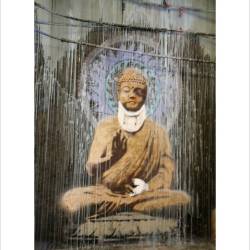Artwork of Banksy
An emblematic figure of the arts, in the line of street art, Banksy is a name that resonates with mystery and fascination, thanks to a whole collection of ephemeral works and an anonymity firmly preserved over the years. From his beginnings in Bristol to his explosion around the globe, from major capitals to the Palestinian ghetto, with retrospectives and works in the collections of major museums such as the Banksy Museum in Paris, the Banksy Museum in Brussels and Amsterdam, the Moco Museum in Amsterdam, and the Gallery of Modern Art in Glasgow, the graffiti artist has revolutionized the art scene with provocative and thoughtful works, leaving an indelible imprint on the walls of many cities across the planet.
Discover Banksy's work with “The Son of a Migrant from Syria”, presented in the Calais ghetto and stemming from his commitment to migrants in Calais, “Girl With Balloon”, partially destroyed at an auction, in the artist's provocative vein, works from his New York residency “Better Out Than In”, a collection of political graphitis in the heart of New York, and “Flower Thrower”, a peace-promoting urban art stencil created in the West Bank.
Grab yourself a Banksy print, and discover the work of the world's most famous and anonymous street artist by browsing his biography.
Banksy's biography
Banksy's beginnings in Bristol
Born in Bristol, supposedly in 1974, Banksy became interested in graffiti and urban art as a whole at an early age, around 14 or 15. However, it wasn't until the late 1990s that he made his breakthrough onto the art scene. It was then that his unique style began to take shape, with the artist quickly adopting the stencil technique to deliver powerful and often subversive messages in the city of Bristol. It was also in these years that Banksy joined the artists' collective known as Bristol's DryBreadZ Crew, allowing him to develop his skills and begin to draw attention to his work.
Banksy in London: urban expansion
After conquering Bristol, Banksy turned his attention to London. In this cosmopolitan city, he found fertile ground for his creations. Stencils such as “The Girl With the Balloon” appeared on walls, immediately capturing the attention of Londoners. Over the years, the artist scattered his paintings across the city, from the City of London district, with “I love London, Robbo” or “Banksy Basquiat”, to Southwark, opposite the City and in the heart of London, where he painted “Banksy's Boy Fishing”, to Lambeth and Waterloo station, home to the Leake Street Graffiti Tunnel, where Banksy invited graffiti artists from all over the world to express their street art talents on the tunnel's 300m wall, with the agreement of London City Council. Turning England's capital into an open-air exhibition space, Banksy tackles thoughtful subjects such as politics, war and consumerism, taking a critical look at the world around us, often in opposition to what the City of London and its financial center represent for the country.
Banksy's technique
To create his series of works, Banksy mainly uses the stencil technique. This atypical method, requiring advance preparation, enables the street artist to intervene quickly and effectively, often under cover of night. The choice of this method also facilitates the reproduction of his work, like a photo of his work, contributing greatly to its worldwide distribution. By adding realistic, photo-like pictorial elements and powerful texts, Banksy's messages resonate far beyond the borders of London and England.
Banksy's interventions across the planet
Banksy has left his artistic mark all over the planet, transforming the streets of many cities into veritable open-air galleries. His daring and provocative interventions have been reported in many international cities, from New York to Paris, via Toronto and even Bethlehem or Calais. Each Banksy intervention creates a considerable media buzz, drawing public attention to socio-political and environmental issues. His works, often placed in strategic locations, are powerful statements that spark conversation and debate. Whether setting up a stall selling paintings in New York's Central Park or painting graffiti on the Israeli-Palestinian separation wall in Bethlehem, Banksy uses art as a powerful tool to raise public awareness of important issues.
Paris and France: A special country for Banksy
Banksy has also left his mark on the cities of France, and Paris in particular. His interventions, though discreet and often ephemeral, have attracted considerable attention. Among his most notable achievements are several frescoes on the theme of migration, a subject at the heart of current social and political events. His works have been discovered in strategic locations across the capital, such as the Bataclan district, where a poignant tribute to the victims of the 2015 attacks was found. Despite their ephemeral nature, Banksy's work in France continues to provoke debate and captivate attention, affirming the artist's role as social provocateur and cultural commentator.
Banksy in New York and North America
One of his most striking projects in New York, and a real page in his career, is undoubtedly his “Better Out Than In” residency in 2013, with which, for an entire month, Banksy unveiled a work each day in different locations around the city. Each work was accompanied by an audio commentary available via a free phone number, offering viewers an immersive and interactive experience. Notable works from the “Better Out Than In” residency include “The Sirens of the Lambs”, a mobile installation featuring stuffed farm animals in a butcher's truck, and “Hammer Boy”, a graffiti depicting a young boy playing hopscotch with a giant hammer. These works captured the attention of the public and the media, sparking debates on the themes of meat consumption, childhood and violence.
Outside New York, Banksy has also made several interventions in North America. In Toronto, Canada, he left several stencils on the city's walls, including one depicting a policeman with a heart-shaped balloon, a powerful image that provoked numerous interpretations. In New Orleans, Banksy left his mark on the city's walls with poignant works, including commentaries on the devastation of Hurricane Katrina, underlining his socio-political commitment.
Banksy's special projects and collaborations: The examples of Calais and Bethlehem
In addition to simple wall stencils, Banksy has also launched large-scale art projects. His ability to surprise and innovate made him a pioneer in the field of contemporary urban art.
After a first visit to the West Bank in 2005 with his “Santa's Ghetto” project, Banksy founded the “Walled Off” hotel in 2017, located opposite the much-discussed Israeli separation wall. This unique establishment incorporates many of the artist's works, attracting tourists from all over the world. The hotel also serves as a place of residence for other guest artists, providing a creative space conducive to cultural exchange. This hotel project underlines Banksy's commitment to global causes and his desire to raise public awareness through art.
In Calais, another major Banksy project, the artist highlights the migrant crisis by installing several poignant works in the “Calais Jungle”, a refugee camp. These interventions denounce the precarious living conditions of migrants and aim to create a global awareness of this alarming humanitarian situation. His painting of Steve Jobs, the son of a Syrian migrant, remains one of the most memorable, highlighting the potential hidden among the refugees.
Other notable Banksy coups
Although Banksy often opts for temporary media, this hasn't stopped the art market from snapping up his creations. His works are frequently put up for auction, fetching astronomical sums and breaking sales records. In response to this, in 2013, during his residency in New York, Banksy set up an anonymous stall selling genuine paintings by the artist for just $60 each, a fraction of their real value. The widely publicized operation was seen as a critique of the commercialization of art.
In 2015, Banksy opened Dismaland, a dystopian parody of traditional theme parks. Located in Weston-super-Mare, England, the project attracts thousands of visitors and brings together works by over 50 international artists. This offbeat exhibition offers incisive reflection on contemporary themes such as consumer society and the environment, further cementing Banksy's reputation as a street art visionary.
In 2020, Banksy funded the Louise Michel project, a lifeboat designed to rescue migrants in the Mediterranean. Named in homage to a French anarchist figure, the vessel features a Banksy work depicting a little girl in a life jacket holding a heart-shaped buoy. This initiative once again underlines the artist's commitment to humanitarian issues.
Banksy: Record-breaking auctions
Although regularly denouncing the financial excesses of the art world, Banksy's creations frequently fetch a record price for the sale of street art at auctions. In 2018, his work “Girl With Balloon” captivated the world when it partially destroyed itself after being sold for the record sum of 1.2 million euros, revealing at the same time a mechanism hidden in the frame, and creating a new page in the history of art auctions. This unexpected performance gave rise to another version entitled “Love is in the Bin”, which reached even greater heights at subsequent resales, with a price approaching £18.6 million (€21.8 million). In each sale Banksy thus challenges the conventions of the art market, transforming expectations and redefining the perception of artistic value.
Cultural influence and media omnipresence
The fame of Banksy extends far beyond art lovers. His work has become a symbol of resistance and free expression, reaching a vast audience through photography and social networks. Photos of Banksy's works circulate massively on the Internet, propelling each creation into global trends. Making intelligent use of social platforms, Banksy plays with his own anonymity, posting directly to his Instagram account to share his work. Each post brings immense fervor among his millions of followers, guaranteeing immediate and international visibility.
Banksy also knows how to capture the attention of the mainstream media, his actions being reported by the most prestigious art publications across the planet. Whether it's a new painting that appears overnight or a daring intervention, every gesture becomes the subject of discussion, like a new page in art history, analysis and speculation. The example of the “Valentine's day mascara” graffiti, denatured by Margate town council after workers removed a real freezer as an integral part of the work, shows the artist's influence when, after protests from followers via instagram post or other means of communication, the removed object reclaimed its place with the intervention of the town council.
Videos documenting his interventions, sometimes available in documentaries or official publications, add to his mystery and reinforce his iconic status. Numerous works, such as the book “War and Spray” or “The Man Behind the Wall”, also demonstrate the fascination of art enthusiasts with this unique artist.
The mysterious identity of Banksy
Despite his worldwide celebrity, the street artist having marked a veritable page in the arts over the years, Banksy's real identity remains a well-kept secret. Speculation abounds as to who this enigmatic artist might be.
Among the current theories, some suggest that Banksy could be Robert Del Naja, a member of the musical group Massive Attack. Others claim he is Robin Gunningham, a graffiti artist from London. And some believe that Banksy is not a single person, but rather a collective working under the same pseudonym. Whatever the truth, the veil of mystery surrounding the artist contributes greatly to the Banksy legend, continually fueling discussion and research around his true person.
Banksy seems to guard this line of anonymity, and use every means at his disposal to preserve it. He generally works out of sight, often at night, and avoids public appearances. This strategy not only protects his identity, but also confers an intriguing aura around his work, increasing its interest and value. The mystery maintained stimulates public curiosity and reinforces the impact of each new creation suddenly appearing in cities.





























